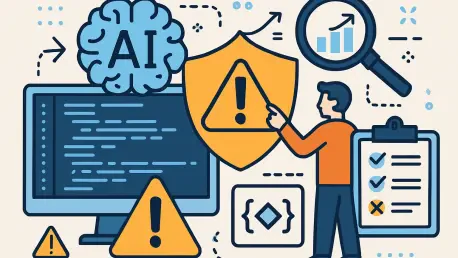Imagine a scenario where a global tech powerhouse like Meta can roll out software updates without the constant fear of catastrophic system failures that could affect millions of users and advertisers in an instant. This is no longer a distant dream but a reality, thanks to the Diff Risk Score (DRS), an innovative AI-powered tool built on a fine-tuned Llama Large Language Model (LLM). Designed to predict the risk of code changes triggering production incidents—known as severity events (SEVs)—DRS is fundamentally reshaping how software development risks are managed at an unprecedented scale. By providing predictive insights, this technology not only safeguards user experience but also protects critical business outcomes, setting a new standard for safety in the tech industry. As software systems grow increasingly complex, the emergence of such a tool marks a pivotal moment, addressing long-standing challenges with a blend of precision and efficiency that promises to redefine development practices.
The Genesis of Diff Risk Score
Addressing High-Stakes Challenges
The creation of DRS stems from the urgent need to manage the immense risks inherent in Meta’s sprawling global operations, where even a minor production incident can ripple out to impact millions of users and disrupt advertiser confidence. Operating at such a vast scale means that every code change carries the potential for significant consequences, making robust risk management not just a priority but a necessity. Traditional approaches often fell short in addressing these high-stakes scenarios, leaving gaps in reliability that could prove costly. DRS steps into this breach by leveraging AI to analyze code changes and associated metadata, generating risk scores that pinpoint potential issues before they escalate into full-blown SEVs. This proactive stance represents a seismic shift from older, reactive methods, allowing for a more controlled and confident approach to software updates in an environment where the margin for error is razor-thin.
Moreover, the sheer scale of Meta’s infrastructure amplifies the complexity of maintaining system stability amidst constant innovation. A single glitch during peak usage periods can lead to widespread outages, eroding trust and causing financial repercussions. DRS tackles this by offering a granular assessment of each code modification, identifying specific snippets that might pose a threat. This detailed evaluation empowers engineering teams to address vulnerabilities early, minimizing the likelihood of disruptions. Unlike blanket policies that might overcorrect and stifle progress, this AI-driven solution provides a tailored perspective on risk, ensuring that safety measures are both effective and adaptable to the unique demands of a global tech ecosystem. The result is a framework that not only protects but also aligns with the dynamic nature of modern software demands.
Balancing Act
Historically, Meta relied on code freezes during sensitive periods like the Cyber 5 holiday shopping week to prevent incidents, prioritizing system reliability over all else. While effective in reducing the chance of SEVs, these freezes came at a steep cost to developer productivity, halting the deployment of updates and stalling innovation during critical times. DRS introduces a groundbreaking alternative by enabling the identification of low-risk code changes that can be safely implemented even during these high-stakes windows. This nuanced approach ensures that reliability remains uncompromised while allowing developers to continue their work without unnecessary interruptions. By redefining the boundaries of what is possible during traditionally restrictive periods, DRS strikes a vital balance that benefits both system integrity and the pace of development.
This balance is not merely theoretical but a practical solution to a long-standing tension in software engineering. Code freezes, though protective, often created bottlenecks that frustrated teams eager to roll out improvements or fixes. With DRS, the focus shifts to intelligent risk assessment, where AI evaluates the potential impact of each change and filters out those unlikely to cause harm. This means that during peak events, when user engagement and business stakes are at their highest, Meta can maintain a steady flow of low-risk updates without fear of destabilizing the system. Such a strategy not only preserves user trust but also empowers developers to stay agile, ensuring that innovation does not grind to a halt under the weight of caution. The implications of this shift are profound, setting a precedent for how large-scale tech operations can navigate risk without sacrificing momentum.
Real-World Impact and Versatility
Productivity and Reliability Wins
The real-world impact of DRS became strikingly evident during a major partner event in 2024, when Meta successfully deployed over 10,000 code changes with minimal production impact—an achievement that would have been unthinkable without the tool’s predictive capabilities. This milestone underscores how DRS enables developers to maintain their momentum during critical periods, traditionally marked by strict code freezes, without risking system stability. By accurately identifying changes unlikely to cause SEVs, the technology reduces the engineering overhead tied to incident management, freeing up resources for innovation rather than damage control. This success story illustrates the transformative power of AI in achieving a seamless integration of productivity and reliability, proving that safety and progress can indeed coexist even under the most demanding circumstances.
Furthermore, the significance of this achievement extends beyond the numbers to the broader implications for operational efficiency. Deploying thousands of updates during a high-stakes event without disruption signals a departure from the cautious, often paralyzing, strategies of the past. DRS provides a safety net that allows Meta to push boundaries while keeping risks in check, ensuring that user experience remains smooth and business outcomes are protected. This dual benefit highlights the tool’s role as a catalyst for sustainable growth in software development. Teams no longer face the dilemma of choosing between delivering new features and maintaining system integrity; instead, they operate within a framework where informed decisions drive progress. Such outcomes validate the investment in AI-driven risk management, showcasing its capacity to redefine operational norms at a global scale.
Multi-Faceted Applications
DRS demonstrates remarkable versatility, powering 19 distinct use cases and continuing to expand its reach across Meta’s software development lifecycle. From optimizing build and test selection to facilitating reviewer assignments and conducting release risk analysis, the tool touches every phase of the process, enhancing both efficiency and quality. Supported by the Risk Awareness Platform (RAP), DRS integrates seamlessly with various tools and APIs, delivering risk-aware features that streamline workflows and conserve computational resources. This comprehensive approach ensures that risk management is not a standalone effort but a deeply embedded aspect of development, addressing challenges at multiple levels. The breadth of applications underscores DRS as a cornerstone of modern software engineering practices, capable of adapting to diverse needs within a complex ecosystem.
Additionally, the impact of these varied use cases is amplified by the way DRS fosters a culture of proactive problem-solving. By providing insights into potential risks at different stages—whether during planning, coding, or post-release monitoring—the tool equips teams with the foresight needed to make strategic decisions. For instance, optimizing build processes reduces unnecessary resource consumption, while informed reviewer assignments ensure that expertise is applied where it matters most. This holistic integration means that every facet of development benefits from a layer of AI-driven intelligence, minimizing the chance of oversight. As a result, product quality improves alongside developer efficiency, creating a virtuous cycle of innovation and stability. The ongoing growth in DRS applications suggests that its influence will only deepen, shaping how large-scale tech operations manage complexity in an ever-evolving landscape.
Future Horizons for Risk-Aware Development
Innovative Aspirations
Looking ahead, Meta is charting an ambitious path for DRS, aiming to extend its predictive capabilities beyond code changes to encompass configuration changes, which pose their own unique risks in software environments. Plans also include automating risk mitigation through AI agents, reducing manual intervention and accelerating response times to potential threats. Additionally, efforts are underway to enhance transparency by providing natural language explanations for risk scores, making the tool’s assessments more accessible and actionable for developers. These forward-thinking initiatives reflect a commitment to continuously refine risk-aware software development, pushing the boundaries of what AI can achieve in managing complex systems. By addressing emerging challenges with cutting-edge solutions, Meta is positioning DRS as a pivotal force in the future of tech safety.
Equally compelling is the potential for these advancements to redefine developer interaction with risk management tools. Configuration changes, often overlooked in traditional risk assessments, can silently undermine system stability, and bringing them under DRS’s purview could prevent subtle yet devastating failures. Meanwhile, AI agents promise to transform reactive troubleshooting into a streamlined, automated process, allowing teams to focus on creative problem-solving rather than firefighting. The push for natural language outputs further democratizes the technology, ensuring that even non-specialists can grasp the rationale behind risk evaluations and act accordingly. Together, these developments signal a holistic evolution of DRS, aiming not just to predict risks but to create an intuitive, self-sustaining framework for safety. This vision underscores a broader mission to make software development more resilient in the face of ever-growing complexity.
Industry-Wide Relevance
The significance of DRS transcends Meta’s internal operations, aligning with broader industry trends toward automation and data-driven decision-making in software engineering. By shifting from reactive incident handling to proactive risk assessment, the tool embodies a paradigm that many tech giants grapple with as they balance reliability and innovation. DRS offers a potential blueprint for others facing similar challenges, demonstrating how AI can resolve the perennial tradeoff between system safety and development speed. Its success in a high-stakes environment suggests applicability across diverse contexts, where predictive insights could mitigate risks before they materialize. This alignment with industry needs positions DRS as a model for widespread adoption, potentially influencing standards of practice in risk management.
Beyond its immediate applications, DRS serves as a catalyst for dialogue about the role of AI in shaping software engineering’s future. The challenges it addresses—such as maintaining stability amidst rapid iteration—are universal, affecting companies of all sizes in an increasingly digital world. As automation becomes a cornerstone of tech operations, tools like DRS highlight the value of intelligent systems in navigating uncertainty. Other organizations could adapt its principles to their unique environments, customizing risk-aware features to suit specific workflows or user bases. This adaptability makes DRS not just a solution for Meta but a reference point for innovation across the sector. Its emergence signals a maturing field where data-driven foresight could become the norm, fundamentally altering how risks are perceived and managed in software development globally.
A Balanced Perspective on AI Innovation
Pragmatic Outlook
While DRS marks a significant leap forward in AI-driven software safety, it is important to recognize its limitations, particularly the statistical nature of its risk predictions which, by design, cannot guarantee absolute certainty. Some features, such as configuration risk prediction, remain in early development stages, facing hurdles in accuracy and scope that require further refinement. These constraints highlight the reality that even advanced tools like DRS operate within a framework of probabilities rather than certitudes, necessitating ongoing vigilance from engineering teams. Acknowledging these boundaries ensures that expectations remain grounded, preventing over-reliance on the technology while still appreciating its transformative impact. This realistic view fosters a balanced approach to integrating AI into high-stakes environments, where continuous improvement remains a guiding principle.
Additionally, the evolving nature of DRS’s capabilities points to the broader challenges of deploying AI in dynamic, real-world settings. Statistical models, while powerful, can sometimes miss nuanced risks that fall outside historical data patterns, requiring supplementary human judgment to fill gaps. The early-stage status of features like configuration analysis further underscores the need for iterative testing and validation to enhance reliability over time. Rather than viewing these as setbacks, they should be seen as opportunities to strengthen the tool through targeted research and development. Such a pragmatic stance ensures that DRS is not treated as a final solution but as a work in progress, capable of adapting to new threats as they emerge. This mindset is crucial for sustaining trust in AI-driven systems, ensuring they evolve in tandem with the complexities of modern software landscapes.
Community Engagement
Meta’s approach to DRS also reflects a commendable openness to collaboration, recognizing that the challenges of risk-aware software development are best addressed through shared learning with industry peers. By expressing eagerness to exchange insights and explore joint research, the company signals a commitment to advancing not just its own capabilities but the field as a whole. This collaborative spirit is particularly relevant for open research areas like improving LLM explainability, where collective expertise could accelerate progress. Engaging with the broader tech community ensures that innovations like DRS benefit from diverse perspectives, potentially uncovering new applications or methodologies. Such partnerships could amplify the tool’s impact, driving industry-wide standards for safety and efficiency.
Moreover, this willingness to collaborate highlights the interconnected nature of today’s tech challenges, where no single entity holds all the answers. By inviting dialogue on topics like configuration risk and transparency in AI outputs, Meta positions DRS as a starting point for broader innovation rather than a proprietary endpoint. This approach could inspire other organizations to contribute their own findings, creating a feedback loop that refines risk management practices across sectors. The emphasis on community engagement also ensures that DRS remains adaptable, incorporating external advancements to stay ahead of emerging risks. Ultimately, this outward-looking perspective enriches the tool’s development, fostering a collective effort to make software systems safer and more reliable. It is through such a balanced and collaborative lens that DRS has carved its path, setting the stage for future strides in addressing software safety with actionable, industry-aligned solutions.









